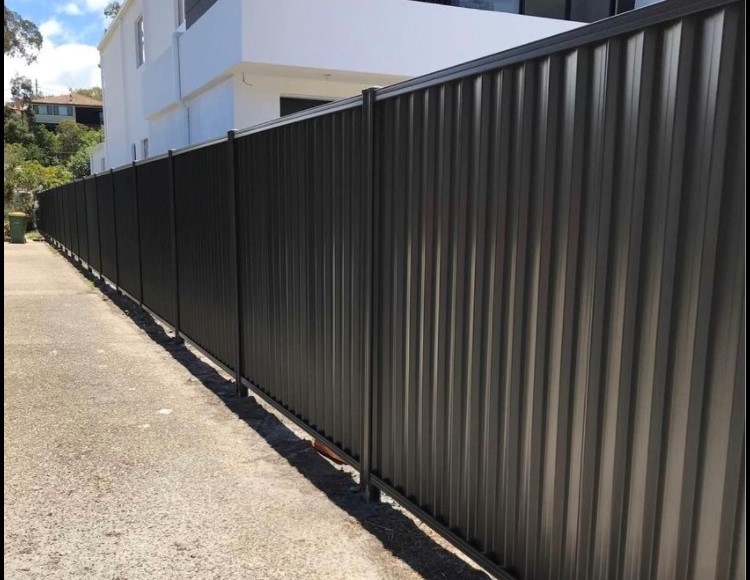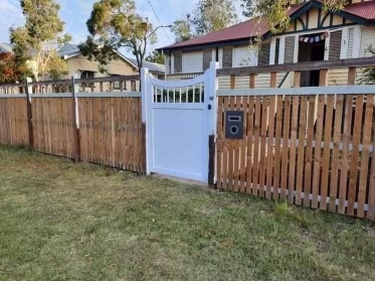Comparing Timber and Colorbond Steel Fencing: Making the Right Choice for Your Property
Enhancing your home with a fence offers numerous benefits, such as providing security for pets, creating a safe area for children to play, ensuring privacy, and even boosting the resale value of your property. However, when it comes to selecting a fence, it’s essential to find the best value for your investment. In addition to choosing a fence that complements your landscaping and aesthetics, factors like low maintenance and durability across seasons are crucial. To help you make an informed decision, here is your comprehensive guide to choosing between Colorbond steel fencing and timber fencing for your property.
Colorbond Fencing

Colorbond fencing sets itself apart as more than just a painted steel panel. Its inner base is made of Zincalume, a blend of zinc and aluminum, adhering to stringent Australian Standards for strength, durability, anti-corrosion properties, and quality. The steel is fortified with a robust corrosion-resistant coating, undergoes pretreatment, and is topped with an exterior-grade paint that resists blistering and flaking. Rigorous testing ensures that Colorbond fencing remains unaffected by harsh weather conditions, guaranteeing its long-lasting and flawless appearance over time.
Durability
Given the specialized construction of Colorbond, it’s no surprise that this material is highly regarded for its durability. Not only is Colorbond fencing resistant to rot and warping, but it is also unappealing to pests and termites, ensuring its longevity and structural integrity. Additionally, Colorbond is fire-rated, providing an extra layer of safety and peace of mind. With these exceptional features, Colorbond fencing stands out as a reliable and long-lasting choice for your property.
Maintenance
With the many maintenance tasks that come with owning a home, you can rest easy knowing that your Colorbond fence won’t be one of them. Unlike other fencing materials, Colorbond fences do not require repainting or staining to maintain their appearance. Simply washing them down with warm soapy water on occasion is enough to keep them looking their best.
Price and Longevity
Despite the higher initial cost compared to timber fencing, Colorbond offers excellent durability and low maintenance requirements. When considering its extended lifespan of up to 10 years longer than timber and the reduced maintenance costs, Colorbond proves to be a cost-effective choice in the long run. While the upfront investment may be higher, the longevity and lower maintenance expenses make Colorbond fencing a financially favorable option over time.
Security and Style
While steel fencing may not appeal to everyone, Colorbond offers a wide range of colors to suit your personal taste and complement the aesthetics of your property. The solid panels of Colorbond fencing have a sleek and modern appearance, featuring clean lines that enhance the overall look. With no gaps or easily detachable slats, Colorbond fences provide a high level of security, making them difficult to climb over. The design minimizes footholds, further enhancing the safety and integrity of the fence. With Colorbond, you can achieve both style and security for your property.
Timber Fencing

Timber fencing holds a timeless appeal, offering a classic and natural look with a wide range of wood types, textures, grains, and finishes to choose from. It provides the flexibility to stain, varnish, or paint the timber to customize its appearance to your liking. The majority of timber fences are constructed using treated pine wood, which is specially treated to enhance its resistance to weather elements and pests, ensuring long-lasting quality.
Durability
Wood treatments play a crucial role in enhancing the resistance of timber fencing to harsh weather conditions. Chemically treated panels not only withstand the elements but also prevent issues like fungi and pest infestation or damage. However, it’s important to note that compared to Colorbond, timber fencing is more susceptible to rot and can potentially warp if not adequately treated and maintained, especially under extreme weather conditions.
Maintenance
Timber fencing typically requires some level of maintenance, which can vary depending on the type of wood and coating used. Periodic touch-ups with paint, varnish, or oil may be needed to maintain the fence’s appearance and protect it from the elements. Applying a sealant is also recommended to enhance water and rain protection as the fence naturally wears over time. While the frequency of maintenance tasks may not be too frequent, it is important to factor in the occasional need to purchase these additional materials for upkeep when necessary.
Price and Longevity
Generally, wooden fences have an average lifespan of about 15 years. With extra care and maintenance, this lifespan can be extended by a few more years. It’s worth noting that wood fencing is generally a more affordable option than Colorbond. However, it is important to consider that the lifespan of a wooden fence is about 10 years shorter than that of a Colorbond fence.
Security
When it comes to security, timber fencing offers a certain level of protection, but it is important to note that it is not completely burglar-proof. Timber fences typically consist of slats, both vertical and horizontal, which can be easier to climb over compared to steel panels. Additionally, timber fences may be more susceptible to snapping or dismantling. If you prefer the aesthetic of timber fencing, it is crucial to prioritize security by ensuring you have a secure, thick, and well-installed unit.
If you’re seeking a cost-effective and quick solution, timber fencing can be a favorable choice.
Colorbond fencing, although it requires a higher initial investment, offers several advantages such as durability, low maintenance, and color versatility. Unlike timber fencing, Colorbond is designed to last longer and requires minimal upkeep. With a wide range of color options available, Colorbond allows you to choose a fence that complements your property and landscape design. When deciding between the two options, it’s essential to consider the amount of effort you are willing to dedicate to maintenance and the overall value you’ll receive for your investment.
